Are your cupboards looking a little bare? It might be time to start stockpiling food! Don’t panic — you don’t have to break the bank to do this. We’re about to share ALL the secrets to building an affordable food stockpile. By the end of this post, you’ll be a certified PRO!
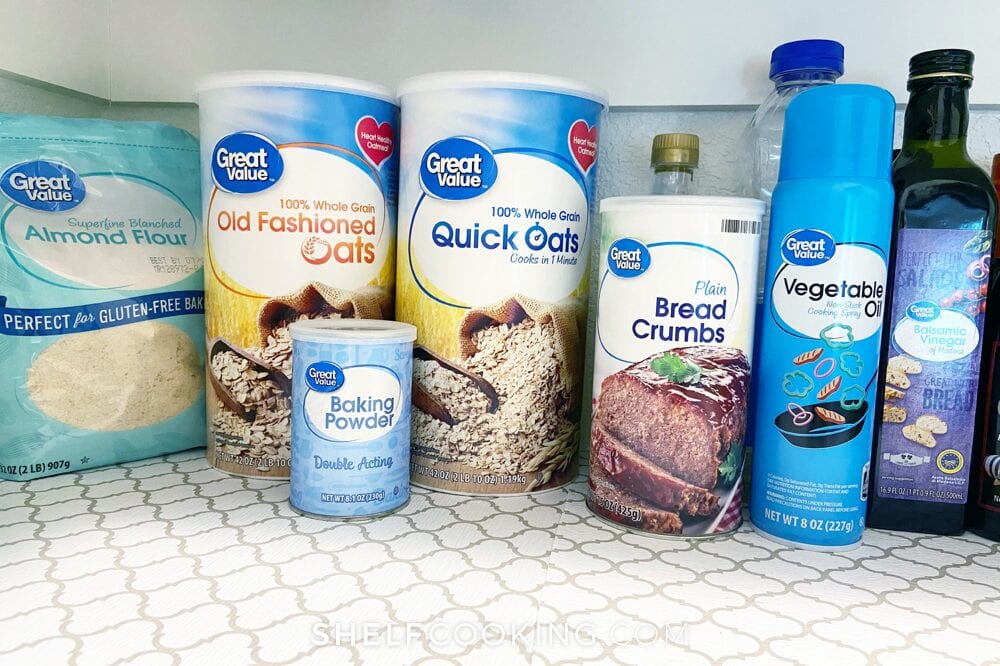
To really get into the spirit of shelf cooking, you've got to have food on the shelves to work with! So, what's a frugal foodie to do to prevent running low on supplies? Start stockpiling!
*Note: When you click the links in this post, we may receive a commission at no extra cost to you.
Before you get overwhelmed, take a deep breath. We're here to tell you that you don't have to bust your grocery budget to build up a healthy food stock. A little planning goes a long way! Over the years, we've learned some valuable lessons about stocking foods, and we're about to break it all down for you.
STOCKPILING FOOD STEP ONE: SET YOUR BUDGET
Before you run out and buy every BOGO item at the grocery store this week, put your credit card down and grab the calculator. Let's make a plan! The goal of stockpiling food is to help you prepare for the unexpected and to save money.
If you've been following our blog for a while now, then you know that shelf cooking is all about learning to use what you've got rather than making multiple grocery runs. This same rule applies to stockpiling, too. It can be tempting to go nuts and buy out of panic. It's also tempting to fall for deals that are just “too good to pass up.”
We get it. But let's make one thing clear. We're not doomsayers over here, and we're not encouraging you to be, either. Building a stockpile of food isn't meant to stir up fear. Instead, it's a great way to make shelf cooking more manageable and to save money in the long run.
So, all those disclaimers aside, before you start stocking up, figure out how much of your budget you can afford to allocate to building up your food reserves. We suggest starting small! Even adding $10-$20 to your weekly grocery budget can go a long way. If you're looking for more budgetary guidance, definitely check out our Budget Boot Camp!
STOCKPILING FOOD 101: STORAGE
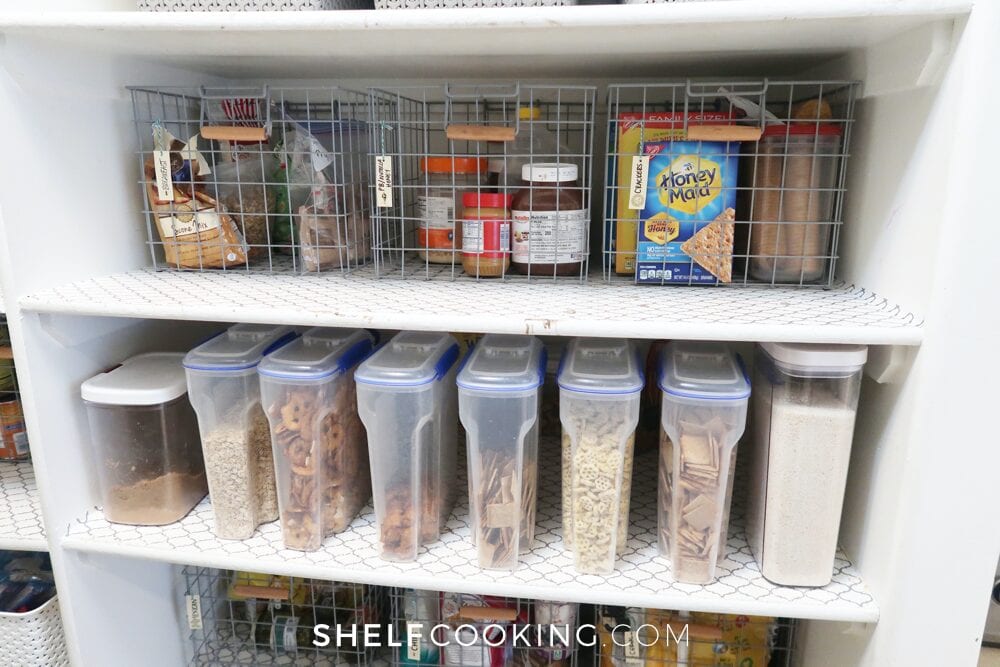
You've made the decision to start a stockpile, you've set your budget, and you're about to get your first haul. Now, where the heck should you store all this stuff?! We've put together a little food storage 101 for ya!
- Freezer – If you can afford to invest in a chest freezer, we say do it. The more space you have to freeze meals, meats, and bread, the better! If you only splurge on one item this Christmas, let it be a freezer. We promise it will pay for itself pretty quickly. Looking for guidance on preventing freezer burn, or wondering how long you can safely store food in the freezer? We've got got a whole post devoted to preventing freezer burn.
- Shelving – Once you start stocking up on canned goods, you'll need somewhere to keep them. If your pantry is on the small size, we suggest installing shelving in the garage, basement, or even a spare bedroom. Bonus points if you organize by type of food! It makes shopping your shelves so much easier.
- Food Storage Buckets – These storage buckets on Amazon are a game-changer if you're storing large quantities of dry goods like flour, rice, beans, or sugar. If you keep them in a cool, dry place, your food will last for thirty years or more.
- Bulk Pantry Containers – You'll also want some smaller food storage containers to store that bulk food in your pantry.
- Mylar Bags – You know those bags campers and hikers use to pack food? They're brilliant for stockpilers, too. Use mylar bags to store dried fruits, meats, or nuts.
Pro Tip: When you're storing meals in the freezer, double wrap with foil. Then use a permanent marker to note the type of food, the date it was frozen, and heating instructions. No more mystery meat for you!
HOW TO FIND THE BEST DEALS FOR YOUR STOCKPILE
Alright, you've got your budget in order, and you've cleared out the space to store your food reserves. Time to go shopping! First, do your research. Here are some quick tips for finding the best deals:
- Don’t Toss the Sales Flyers – We bet your mailbox is filled to the brim with sales flyers. We also bet you toss them in the trash as soon as you walk in the door. Don't! Take a few minutes once each week to peruse the grocery deals and make a game plan. Most weekly sales at food stores run from Wednesday to Tuesday, so keep that in mind.
- Buy in Bulk – When it makes sense, you can save a whole lot of dough by buying in bulk. Portion out what you need for the week, and save the rest for later! Just don't fall for the bulk deals that end up costing you more money. We've got some helpful advice about how to stock up and shop in bulk.
- Shop Around – Pay attention to which of your local grocers and stores serve up the best deals on certain types of foods. While we fully believe in only going to one grocery store per week, that doesn't mean you can't switch up your “normal” store every once in a while to take advantage of those deals! IF you have complete willpower and will only buy what you absolutely need, then feel free to hit up multiple stores. Taking a little extra time can save you some serious cash and help you build up your stockpile more quickly.
Ready to become a stockpiling pro? You'll want to keep reading! We've got some practical tips you can use to build your stockpile affordably, along with some cautionary tales that will prevent you from wasting money.
STOCKPILING FOOD: DOS & DON’TS
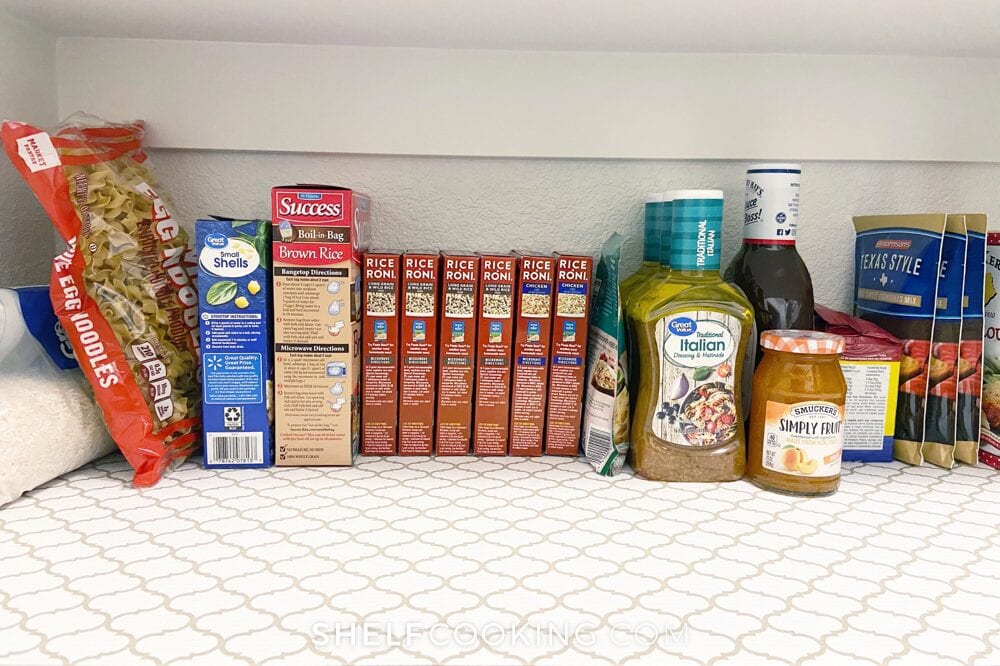
Setting a firm budget and shopping around for deals will help set you up for stockpiling success, but it's also important to be aware of some dos and don'ts. These tips will help you in your journey to stock up on food smartly.
Stockpiling Dos
- Take a Gradual Approach – You don't need to run out and stock your shelves with a three-month supply of food tomorrow! We suggest that you set a goal of accumulating a 90-day supply of food, but we're proponents of a slow and steady approach. Here’s a simple formula to help you get started. Take the amount of food you’d typically need to purchase to feed your family for a day, multiply by seven, and you’ve got a one-week supply. Each week (or month if you’re low on funds), try to buy one extra week's worth of food. Gradually expand and build up to a one month stock, then a three-month supply, etc.
- Buy One for Now, Two for Later – If you follow Shelf Cooking on Instagram, then you're probably very familiar with this tip! It's simple. Let's say you're buying chicken breasts for the week, and they're marked down to $3 off per package. Take advantage of that deal, and buy one pack for this weeks' meals and two more to freeze. Before long, you'll have a freezer full of meats, and you'll be able to spend less and less at the grocery store to keep your family fed.
- Keep an Inventory – It's tough to shelf cook (or stock up on foods) if you don't know what you have on hand! We can’t emphasize enough how important it is to stay organized a keep a running inventory of the food you have available in your pantry, fridge, and freezer. It’s a bit of work, but it will save you SO much time! Use these free kitchen inventory printables to get started!
Stockpiling Don’ts
- Buy Foods You Won’t Eat – Two for one deal on ground chicken! Score! Better buy up a whole bunch, right?! Maybe. Maybe not. Does your family eat ground chicken? Just because a deal is good doesn't mean it's the right deal for you. Save room (and money) for the things your family needs and will use.
- Go Into Debt – Speaking of saving money, let's remember those budgets. The rush of stocking up on killer deals can sometimes cause overeager consumers to go down a dangerous path of overspending. Make a list before you head to the store so you can be a more mindful shopper!
- Buy What You Can’t Store – As you're making your weekly inventory, also take note of how much space you have available. If your pantry is overflowing, it may be a good time to pause on the stocking and use some of your reserves before you replenish them! Remember, stockpiling is about preparedness, not hoarding.
By now, you may be wondering what kinds of foods to buy for your stockpile. We're glad you asked! Let's chat about that for a few.
FOODS TO INCLUDE IN YOUR STOCKPILE
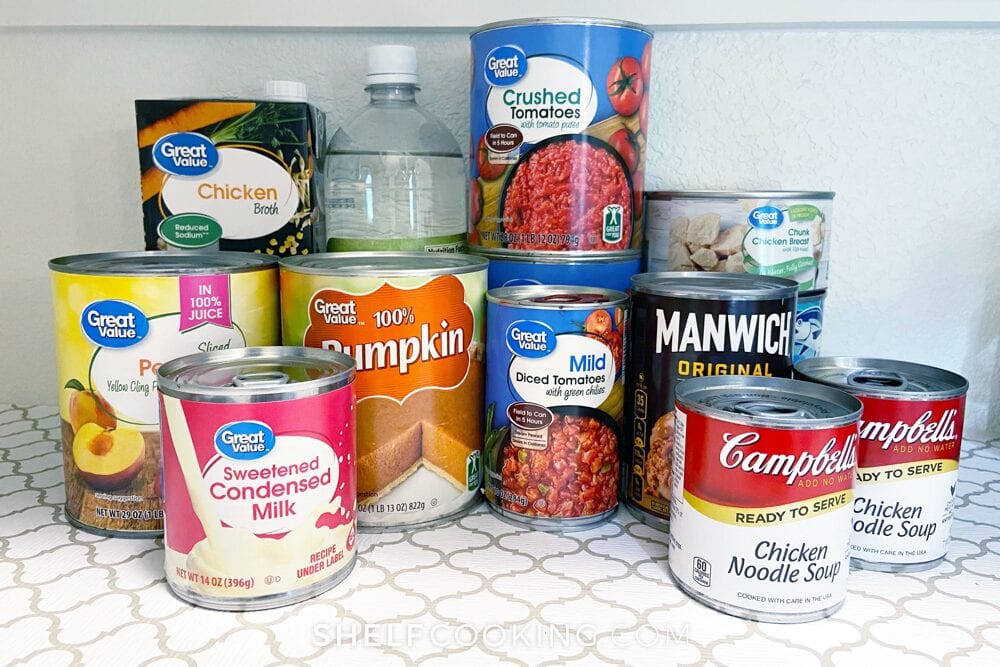
You might be surprised to learn about some of the things you can freeze! There are so many hacks and tricks you can use to store leftovers and preserve fresh foods. But what are the must-have items for any shelf cooker's kitchen? Let's break it down by category:
PANTRY STAPLES
- Proteins – Canned meat works well when you lose power, but it's also an easy way to speed up meal prep. We suggest keeping canned chicken, tuna, salmon, and ham on hand.
- Canned Goods – Fruit, veggies, soups, stews, beans, whatever floats your boat! Canned goods are essential to stockpiling and shelf cooking!
- Dry Goods – Rice, beans, rolled oats, flax seeds, and chia seeds are all shelf cooking must-haves. They last forever, and they make meals extra filling. Be sure to add plenty of dry goods to your stockpiling list!
- Baking Supplies – Basics like flour, vanilla extract, sugar, baking soda, and honey will last quite a while when stored properly. If you see them on sale, stock up!
- Spices – Spices can be pretty expensive, so don't pass them by if you see a good deal. Definitely make sure to keep salt and pepper in stock.
Pro Tip: We put together an exhaustive list of pantry staples! Bookmark it, print it, and add these items to your shopping lists.
FREEZER STAPLES
- Breakfast Items – Mornings are hectic for pretty much everyone! Stockpiling food to grab for breakfast can save you so much time and worry. Try these make-ahead freezer breakfasts we love.
- Soups – A hearty soup is the holy grail of shelf cooking! You don't even need a recipe — throw together some leftovers. If you're looking for inspiration, definitely try this hearty broccoli cheddar soup.
- Casseroles – We sure do love us some casseroles. Tuna noodle, broccoli chicken, you name it. We'll eat it. Here's one of our new faves! Try this easy tamale casserole.
- Meats – Remember our rule from earlier? Buy one for now, two for later. We talk about this a little more in our meat buying video!
- Miscellaneous – If you've got it in your fridge and it's about to go bad, don't toss it! Chances are you can freeze it. Here's a fun fact: you can even freeze avocados. Don't throw away those expensive things! If you see an avocado sale, buy a bunch to freeze.
Pro Tip: As you're whipping up meals for dinner (or breakfast), make an extra batch to freeze for later. You'll soon have a freezer full of meals to pull from. Buh, bye delivery!
FRIDGE STAPLES
- Condiments – When you see condiments your family loves on sale, snag them! Here are a few good things to keep on hand: ketchup, mustard, mayo, soy sauce, lemon juice, lime juice, and Worcestershire sauce.
- Eggs – You'll want to make sure you always have some eggs handy in case you decide to whip up a batch of these freezer breakfast burritos! They're so good, you guys!
- Butter – In addition to all the baking staples in the pantry, you'll want to make sure you have butter on hand. Just so you know, the average shelf life in the fridge is about six months!
- Cheese – We've never met a cheese we don't love, but here's a quick tip. It's so much tastier and cheaper to buy the block kind and shred it yourself with a simple grater. It's healthier, too. Oh, and it melts more easily. You're welcome.
- Milk – If you have kids at home, you probably go through a lot of milk! It's not only good for building strong bones, but it's also a common recipe ingredient. Milk is never a bad thing to have on hand. Try the almond variety if you can't do dairy.
- Plain Greek Yogurt – As you're stockpiling food, don't sleep on yogurt! It is one of the most versatile foods out there! Use it in smoothies, baked goods, or parfaits. It's a great sub for sour cream, and you can freeze it if you need to.
Pro Tip: Use some of that Greek yogurt and the rolled oats in your pantry to whip up a tasty batch of overnight oats! It's a protein-packed meal that's so simple to throw together.
GO FORTH AND STOCK UP
And there you have it! You're now well prepared to start stockpiling food for your family. Where will you shop for all these kitchen essentials? Comment below to let us know where you find your best grocery deals for stocking up.
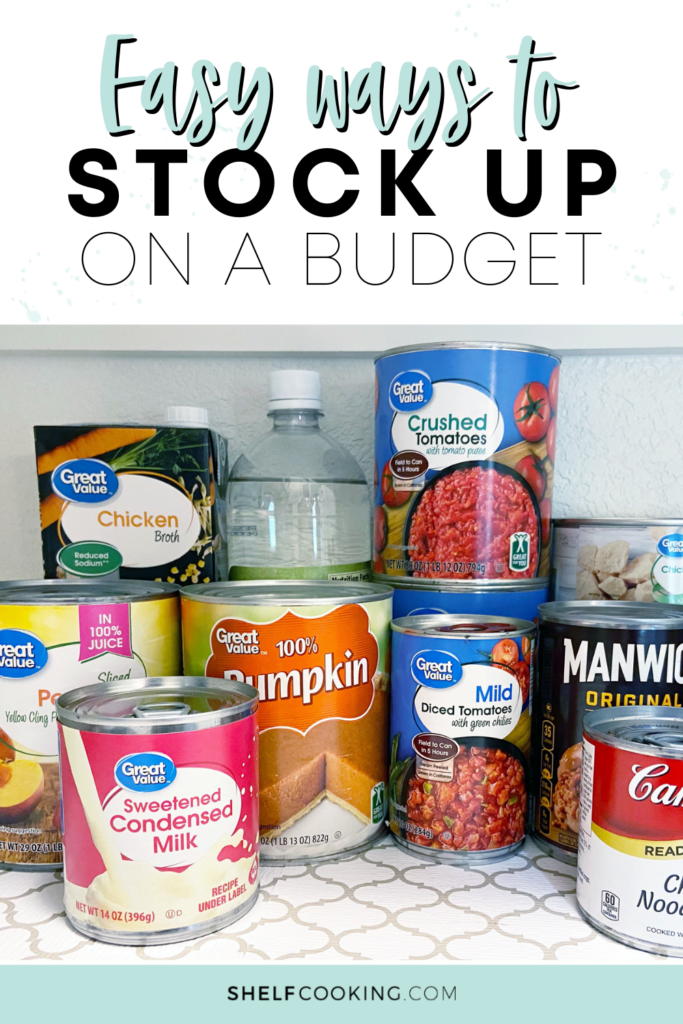
Looking for some incredible meals that are both easy and affordable to whip up? Once you're done stockpiling food, try making these dishes.
- This pumpkin french toast is almost too good to be true!
- These baked chicken recipes are perfect for freezing and making meal planning so easy.
- Make your next Taco Tuesday a breeze with this hack! Learn how to cook ground beef the easy way.
Stock on!

totally agree with entire post, thanks for sharing!!!
This is a great post! We recently installed some shelves in our basement for canned goods, etc.
Thank you for the info , hopefully we never have to use this.